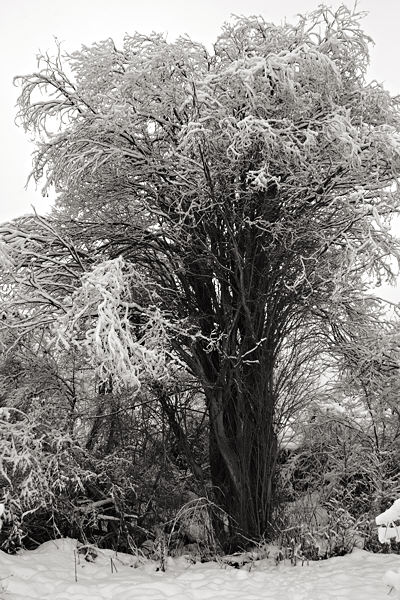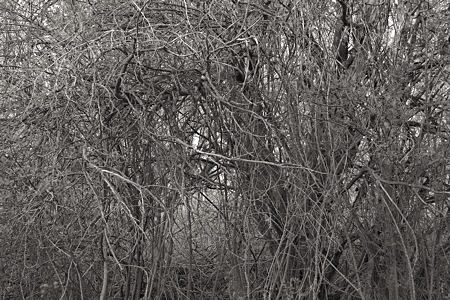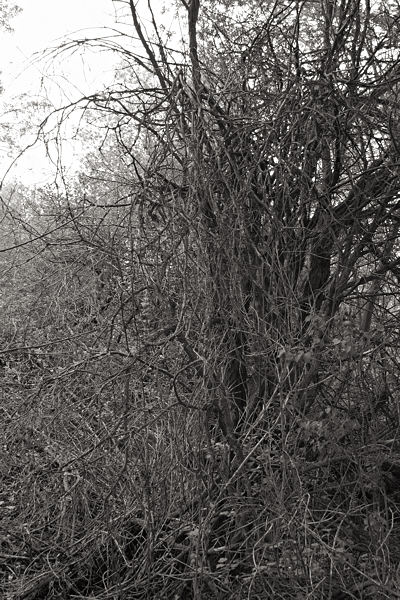Nameless
July 20, 2008
I’m spending a fair amount of time along Sourdough Trail, but I’m spending it, for the most part, by and for myself. Despite maintaining this journal, I’m not primarily concerned with communicating about the place itself. Call it narcissism, but the emphasis has been more on me, specifically on me photographing, most precisely on me photographing in this particular spot. That does entail telling you a little about the place, but not to the extent that I’ve had to develop names.
Furthermore, my communication has been mostly visual. I don’t need to describe the snowy Watchman, standing just before the main bridge, because I can show him to you. And I don’t need to name him Watchman because I probably won’t be speaking of him again. In fact, I haven’t used that name even to myself before now—though he’s one of a set that I thought of loosely as Guardians when I first began photographing here.

Names are clearly needed for a full, communal understanding of place. Names carry meaning. There’s a world of difference between knowing a particular feature as, say, Flounder at the Base of the Creek (Dzántik’i Héeni in Tlingit) or as Gold Creek. In the present case, the fairly generic Sourdough Creek (there must be dozens in every western state) certainly has different associations from its other name of Bozeman Creek. But I’ll leave that social/historical thread for another time.
What I’m wondering now is what difference it might make, for me in my isolation, to create and use names. Does having a name make a feature more salient, more readily, even automatically, distinguished and noticed? Possibly. Still, an actual name seems superfluous. The Watchman stood out on my earliest visits, though he remained unpictured until snow fell. I notice him every time I walk that path. Similarly, I’ve always noticed, and thought of as a distinct entity, the long, nearly horizontal branch I have to duck under on a certain side path. I’ve wanted to photograph it, but haven’t seen the picture yet. Until now, it never occurred to me to give it a name, and I doubt I shall. (If I do, perhaps Long Arm…)

In many respects, at least for my own purposes, a photograph serves like a name. It singles out its subject, which thereafter remains a noticed quantity. For example, the Tangles I pictured late this spring, though noted in a general way before, will doubtless be more regularly observed in future.

A name is not mere shorthand, but adds some personal touch that’s a product of an individual mind, and that ties the named to other things, to the past. The photograph may also call up those associations, but perhaps not as surely and concisely and unfailingly over time. The haiku I wrote in the first phase of this project aimed to capture something along these lines, and I actually used them in place of titles for the photographs. Nevertheless, I think there’s a big difference between a haiku and a name. The haiku, by nature, represented unrepeatable moments. They don’t seem to carry the judgement, almost finality of a name. Recently, I’ve been reveling in changes more than continuities. The light on a leaf never falls the same way twice. Naming even that leaf is naming in vain.
Filed in: Musings.
Heavy duty post Steve. Driving right at cognitive science.
I know I have a strange mind with something similar to a photographic memory. When wandering the woods I always know where I am and it mostly comes from remembering thousands of features. But the memories are not images they are like feelings. As soon as I put a name to a feature (as simple as, my favorite stump) it changes from being a feeling to something concrete. So in order to not get lost I have to literally feel my way back home.
Ever since I matured I have considered “Art” as a means of communicating feelings.
So putting names on things definitely changes the ball game but since your idea is so new to me I have no idea what ball game we are playing.
As I wrote the last paragraph I remembered something Paul Butzi wrote. Something about “If you do it once it’s art if you do many times it becomes a craft” or words with a similar concept.
It seems to me in passing that Paul’s idea is somehow related to your naming thought.
Bob,
I don’t feel that I remember images of things at all well, though I can do a better job recalling something I’ve photographed. However, I’m decent at recognizing places I’ve been before, and I seldom have trouble route-finding if I’m paying attention. I think I navigate by a combination of the feeling you mention, partial recall if I’ve been there before, and the logic of the land. (Of course, that’s hardly necessary in a small place such as my project area.)
I’m not sure whether the concreteness of named things aids in your wanderings or not, but it’s the concretizing by naming that I’m trying to avoid, at least for now. I don’t want to get into the habit of thinking of a particular tree, say, in a certain way, as I more likely might if I gave it a name. It’s true that such familiarity can open new possibilities at the same time it tends to preclude others. And I don’t mind some of the repeated picturing becoming more craft than art, if Paul’s idea applies here. It’s just that I don’t feel I’ve found yet the groove I’d be happy settling into. I was a bit afraid that coming back, after a year mostly away, I would fall into predictable patterns, but I’ve been pleased so far that I’m still doing work that feels new. Not much I’d call good yet, but that’s less to the point.
This is a deeply moving piece. I feel more inclined to sit in the silence with how it affected me than to elucidate. Thank you.
This issue of the naming of things is quite profound, isn’t it? Since first reading your post, I’ve been thinking about the practice of taking another name for yourself in recognition of a life-changing event or simply in acknowledgement of some previously unacknowledged aspect of your self, and also of the idea that to name something is to claim it and to take and have a kind of power over it.
But I wondered also how far would you travel in staying aloof from naming? You seem quite at ease in referring to the branch as “branch” and the snow-spangled tree as “he” and “him.”
Perhaps because so much of my life is taken up with finding the precise word or words for various things, I’m particularly interested in this: “A name is not mere shorthand, but adds some personal touch that’s a product of an individual mind, and that ties the named to other things, to the past. The photograph may also call up those associations, but perhaps not as surely and concisely and unfailingly over time.” It’s not clear to me why you’ve said “ties…to the past” seemingly as an idea co-equal with “ties the named thing to other things.” Do you intend the kind of casual naming that would stop at “tree” and not progress even as far as “oak tree”? Because I find that the desire to precisely articulate and name things, sensations, ideas, what-have-yous can only be accomplished by the kind of exquisite attention to the present that Proust evoked so well in the madeleine moment. (In case you’re not familiar, in the mm, Proust had a sensation that he wanted to articulate, so he stopped time by re-enacting the action that prompted the sensation, which recreated the sensation and prolonged the present until he could get hold of it.) Even if the generally recognized names of these etceteras were learned in the past, their alert deployment in the present to articulate the present can only happen in the present. But “alert” is the key to all this, isn;t it?
I like this idea that the naming of something is a kind of communion with the thing named (rather than a conquering and/or dismissal of it) and that the naming process could be an ever-evolving, to some degree mutual, exploration. The idea that Heraclitus expressed: No man ever steps in the same river twice, for it’s not the same river and he’s not the same man.
I’ve also been thinking about the vagaries of memory and the evocation of things past and present, but this post is long enough as it is and tomorrow is a working day.
be well.
Melanie,
The notion of changing one’s name is a great illustration of the power of names. Here I’m rejecting that power for fear of diminishing the primary visual mode of knowing. It’s difficult to ignore or unlearn a name. Unfortunately, I’ll never forget the words a friend once told me that go to the motive of Schubert’s Unfinished Symphony, and which are a definite distraction from the music (she did warn me, but I was too curious to opt out).
I think the influence is far less for generic names like “branch” or “tree,” which aren’t unique to an individual. I would, in fact, like to go further and recognize species of tree and bush better than I do. Yes, that begins to connect particular trees in a non-visual way, but it seems to matter less, perhaps because it’s not a name of my own creation.
“Ties to the past” arise because in calling a tree a Guardian, say, I’m not only linking it to the other Guardian trees, but to past associations with guardians, such as seeing the guards at Buckingham Palace.
I hasten to add that I’m not claiming that naming or the associations it brings are in any sense bad. It’s just that I’m trying to be aware of their role in perception and experience, and, by way of experiment, am trying to minimize that role for now. “Exquisite attention to the present” is a lovely statement of the goal. For Proust that attention may have been, in part, in service of recapturing the past, but I’m more interested in staying strictly present. Nevertheless, I find equally attractive the idea of communion with a thing that is symbolized and perhaps advanced by naming it; that was exactly the motive for the naming I did before. I expect to return to that mode, at least on occasion, after living a while without it.
Precisely why naming has such power is an interesting question.
I may have bridled too much at your “ties to the past” comment since, ironically, it flung me back into the past and some of my more baffled days of vacationing at an ashram in Lenox.
Is your stardrops imagery a continuation (or extension) of this “in the moment” exploration? The bit about “bright points, rather than the veils woven with longer exposure” seems to sum things rather elegantly (if unintentionally).